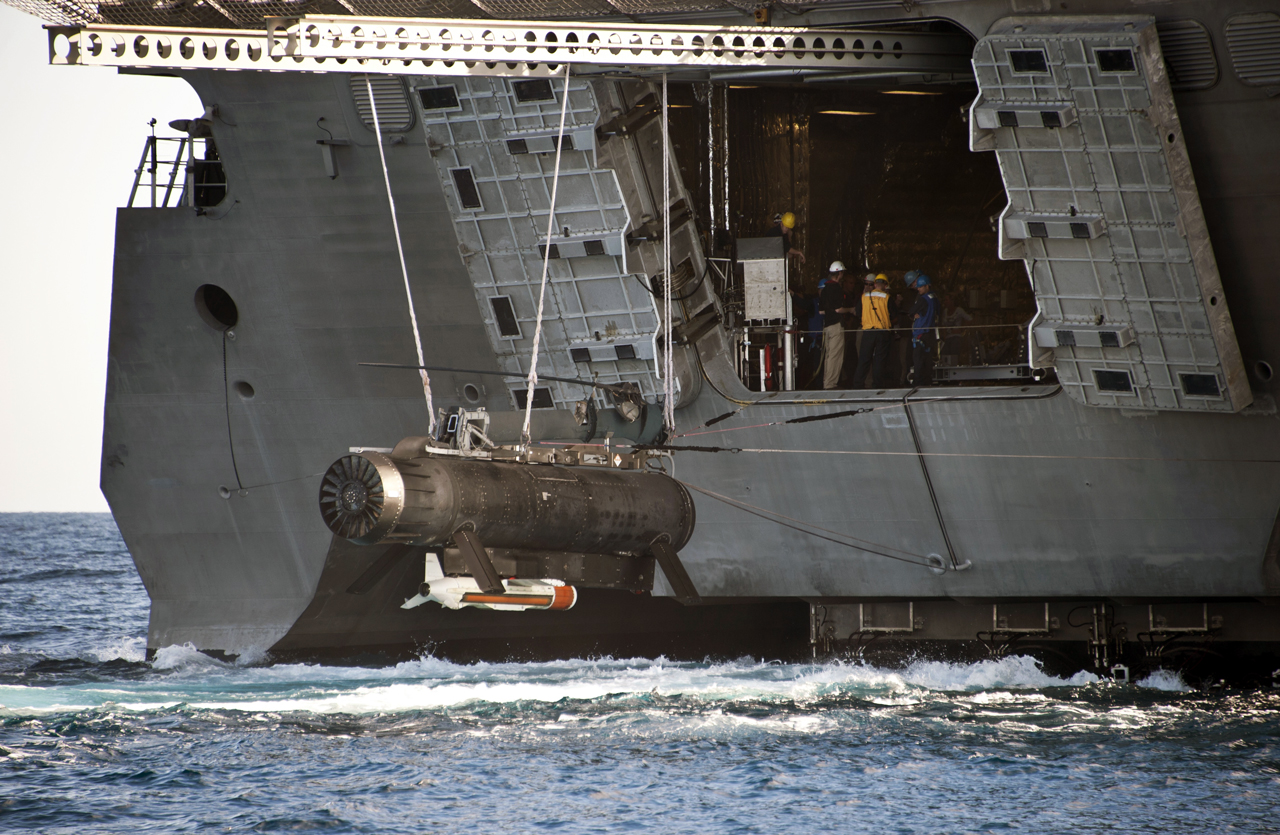
The Littoral Combat Ship program could begin final mine countermeasures mission package testing in November, after reliability concerns delayed the testing by several months, Navy officials told USNI News this week.
The mission package was originally supposed to finish its initial operational test and evaluation (IOT&E) by this month so that, if successful, initial operational capability (IOC) could be declared by Sept. 30, the end of the fiscal year.
However, a slew of reliability problems became apparent over the summer during a technical evaluation at sea aboard USS Independence (LCS-2), LCS mission modules program manager Capt. Casey Moton told USNI News in July.
“At a high level, we’ve been pleased with the performance of the individual MCM systems in detecting, classifying and identifying mines,” he said. “My primary focus right now is reliability. It’s not enough that the systems are good at detecting, classifying and identifying mines – I need to deliver systems that can offer sustained, repeatable performance. And so far, I’m not satisfied with how that’s going. I’m not satisfied with that performance.”
Moton said problems ranged from procedures that needed to be refined, to reliability issues with the LCS ship frame itself, to mission package components failing or not properly integrating with other components.
Given those concerns, the Navy decided to take a few months and focus on fixing problematic procedures and improving equipment reliability. Naval Sea Systems Command spokesman Chris Johnson told USNI News that IOT&E would begin in November “pending a decision to proceed as part of the Navy’s formal Operational Test Readiness Review process.” The program office and Commander of the Operational Test and Evaluation Force (COMOPTEVFOR) would make the decision to proceed, but Johnson could not say when that decision would be made.
In addition to the Navy’s own concerns, Director of Operational Test and Evaluation J. Michael Gilmore wrote a memo in early August expressing concerns about the reliability of the Remote Multimission Vehicle (RMMV), a key component of the mission package. Senate Armed Services Committee leadership, upon reading Gilmore’s concerns, wrote to Navy and Pentagon leadership to suggest that the Navy “review the alternatives [to RMMV] and make sure we are on the correct course, rather than letting the inertia of the status quo continue the program of record on into operational testing and production.”
In a separate report earlier this year, Gilmore wrote that “in the recent phase of LCS developmental … [Remote Minehunting System] reliability problems persisted. These problems include the inability to align the system’s inertial navigational unit, intermittent communications, a lube oil pump failure that caused a mission abort, capture latch impairment that precluded shipboard recovery of the RMMV, degraded electro-optic identification capability resulting in a mission abort and replacement of the AN/AQS-20A towed body, tow cable damage following several snags on underwater objects or mooring cables, and multiple incidents of stuck AN/AQS-20A fins or fin actuation faults. Following LCS developmental testing in 1QFY15, DOT&E determined that RMS reliability (mean time between operational mission failures) was no more than 20 hours and that statistical analysis of all existing data does not yet support the Navy’s assertions of improving RMS reliability” to the required 75 hours mean time between failure.
Despite the concerns, Gilmore would send a team to Florida to conduct the testing if the Navy decides it is ready for Pentagon assessment.
“Dr. Gilmore advises the Navy regarding issues the service may encounter when conducting operational test, but he does not make the decision on whether to proceed with the test,” Pentagon spokesman Air Force Maj. Eric Badger told USNI News.
“That is the responsibility of the Service Acquisition Executive, who normally delegates the decision to the Program Executive Officers. It is up to the Navy to decide, given the demonstrated shortfalls, if it is worth not only the cost of the test, but also the delay in correcting the underlying problems with the system known to exist, associated with proceeding with the operational test as currently scheduled.”
“Whenever the Navy decides to proceed to operational testing, DOT&E will observe the testing and independently evaluate the results,” Badger said.





